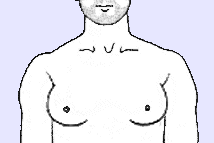|
Physical Problems in Males
|
|
Gynecomastia
|
|
Gynecomastia (from gr. gyne: "woman" and mastos: "breast.") is an atypical, usually benign breast enlargement in males as a result of some hormonal imbalance. The enlargement may be slight or pronounced, temporary or permanent. It may also be asymmetrical, and in rare cases it can be painful. In all cases, a medical examination is advisable, either to reassure the patient or to start some treatment if necessary.
There are two main forms of gynecomastia:
1. “Genuine” gynecomastia, i.e. the development of breast glands. This is usually a temporary phenomenon during puberty (“pubertal gynecomastia”). The condition may last a few months or even one or two years, but it usually disappears at the end of adolescence. Gynecomastia may also develop in adult males. Especially in older men it is not uncommon. Very often, the cause remains unknown. However, in many cases some genetic defect (for example Klinefelter syndrome), underlying disease (for example liver disease), or a certain medication is found to be responsible. In the case of asymmetrical breast development, cancer has to be ruled out. Medical treatment, including possible surgery, will vary depending on the cause.
2. Pseudo-gynecomastia, (also called lipomastia) i.e. a fatty breast enlargment in the absence of real breast tissue. Again, a variety of causes are possible, ranging from obesity to steroid use. In older males, the enlargement may also be an unwanted side effect of taking estrogen for prostate problems. An exact diagnosis will determine the treatment. In severe cases, cosmetic surgery may be desirable.
|


